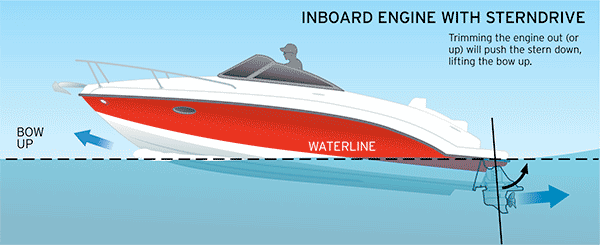OUTBOARD VS. STERNDRIVE - WHICH IS BETTER?
 By: The Salish Seaman
By: The Salish Seaman
Outboard, no stern drive, no wait, it all depends….
In the old days there was a pretty simple decisive line between the two, the original 2-stroke outboard was inexpensive, had tons of get up and go but this performance was at the expense of high fuel burn as well as emitting oily, stinky and annoyingly loud exhaust. Gas was cheap so who really cared about fuel consumption, no one was concerned with emissions standards and when it grenaded you likely just bolted on another one. Alternately the sterndrive, aka inboard/outboard offered a somewhat lethargic, heavy cast iron Detroit 4-stroke engine that was pretty reliable and quiet, and everybody had parts for and knew how to fix a 350 Chevy.
Then the Japanese engineers turned the marine power world upside down by introducing the 4- stroke outboard. The 2–stroke is literally obsolete now with just the one funky-coloured brand planning on hanging on to the remaining very small niche market, so let’s focus on what takes up over 98% of the pleasure craft market share nowadays, the sterndrive and the 4-stroke outboard.
The sterndrive was born by the convenience and affordability of the world’s highest volume engine makers being right here on this continent and over the years we saw Chrysler, Ford and GM battling to get their engines in front of a Mercruiser, Volvo Penta or (horror of horrors) OMC sterndrive. Very high automotive industry volume means an inexpensive motor and the V8 behemoths offered lower revving torque that the outboard didn’t so they became the ideal cruiser drive package which is still their strength. The larger the boat, the less of a drawback the weight and space they use up is. On larger cruisers they are likely below decks, or on a sport boat for the lake the large engine is hidden by seats and likely an attractive upholstered sun pad so the huge footprint of the engine is well disguised. It’s the sports fishing market that was most likely to avoid the sterndrive power package mostly because they didn’t want to sacrifice their prized cockpit space by a large inside-the-boat engine. One big issue was/is the cooling system. A boat uses what it’s floating in to cool the engine, these cast iron engines were designed for the closed cooling system used in a vehicle. Salt water loves to eat cast iron, so the salt water boater was well advised to spend a couple thousand dollars to add a fresh water, aka closed cooling system to his engine(s). Still the end result was a reliable, fairly efficient, relatively low revving engine best suited to plunking along at a sedate cruising speed.

Ford and Chrysler have been out of the marine game a long time now leaving only the General to supply engines for Mercruiser and Volvo Penta, and aside from electronic ignition and EFI nothing really has changed in decades….until recently. In case you haven’t noticed, you can’t go buy a Chevy truck or Camaro any more with a 5.0 litre (305) or 5.7 (350) or 7.4 (454). Those engine designs go back 40-50+ years and the automotive industry don’t wait for no one. Now GM’s vehicles offer a common platform V6 and V8, all aluminum, with VVT (variable valve timing) and greatly improved emissions and efficiency.
Volvo Penta has moved with GM’s new generation of motor so now utilizes these lighter, higher revving and more efficient engines. An added bonus is since the new engines are aluminum, they come standard with the fresh water cooling system. Newer and advanced designs, lighter and more efficient does however cost more. Mercruiser on the other hand has chosen to stay the tried and true path with the same engine platforms as in the past and has setup and/or partnered with other engine builders to produce their engines. These 2 brands dominate the sterndrive market so your choice may very well be dictated by the boat brand you prefer.
One of the most logical rationales behind the superiority of the modern 4-stroke outboard as a marine propulsion system is that these engines ( with the exception of a silver brand adapting a few of their car engines to outboards ) have been designed and manufactured specifically to do what they do - move boats in most likely a salt water environment. These engines are smaller and lighter HP to HP than stern drives due primarily to being one integrated unit (a sterndrive package is made up of 3 significant components – engine, transom shield, and the sterndrive itself) manufactured mostly from aluminum and since they are single purposed, the alloys are specifically chosen for corrosion resistance, as well as the cooling passages are internally coated and contain sacrificial anodes all for the purposes of resisting corrosion.

Higher tech lighter engines are also capable of revving higher so good horsepower can be produced with lower displacement motors, smaller also again means lighter. And features such as variable valve timing are giving these engines the best of both worlds - low RPM torque without sacrificing high RPM horsepower. High HP can also be squeezed from lower displacement motors with things like turbochargers or superchargers and one of the 2 major players is doing just this with their largest outboards. Detractors point out the requirement for premium fuels (try to find that on the water!) plus worry about the maintenance, reliability and longevity of a high-strung motor as a marine engine tends to be used as more of a workhorse than an Italian stallion.
Lighter, smaller, more corrosion resistant are all pretty attractive features for a boat engine, but likely the biggest attraction is how and where the motor fits to the boat. Clearly it fits to the outside of the boat, either in a small motor well on the smaller boats or on a bracket outside the transom on larger boats, thus the impact on internal cockpit space is minimized as compared to a sterndrive package. Could you imagine giving up giving up 10-12 square feet of usable space in the back of your pickup truck?
As mentioned earlier the sports fisherman is the most impressed by this space retention, but even in an 18-19’ ski boat full of family members the benefits of the space savings are substantial. The outboard will cost you more, but the space savings and performance benefits are worth it for many. If you have a floating motorhome type of boat where you set the throttle and cruise for longer distances, the engine is typically hidden below decks so space requirement are less of an issue, and your boat choices will dictate primarily sterndrive or inboards as you progress to larger cruisers.
Check out our Talking Boats Blog Page for more marine articles!
In the old days there was a pretty simple decisive line between the two, the original 2-stroke outboard was inexpensive, had tons of get up and go but this performance was at the expense of high fuel burn as well as emitting oily, stinky and annoyingly loud exhaust. Gas was cheap so who really cared about fuel consumption, no one was concerned with emissions standards and when it grenaded you likely just bolted on another one. Alternately the sterndrive, aka inboard/outboard offered a somewhat lethargic, heavy cast iron Detroit 4-stroke engine that was pretty reliable and quiet, and everybody had parts for and knew how to fix a 350 Chevy.
Then the Japanese engineers turned the marine power world upside down by introducing the 4- stroke outboard. The 2–stroke is literally obsolete now with just the one funky-coloured brand planning on hanging on to the remaining very small niche market, so let’s focus on what takes up over 98% of the pleasure craft market share nowadays, the sterndrive and the 4-stroke outboard.
The sterndrive was born by the convenience and affordability of the world’s highest volume engine makers being right here on this continent and over the years we saw Chrysler, Ford and GM battling to get their engines in front of a Mercruiser, Volvo Penta or (horror of horrors) OMC sterndrive. Very high automotive industry volume means an inexpensive motor and the V8 behemoths offered lower revving torque that the outboard didn’t so they became the ideal cruiser drive package which is still their strength. The larger the boat, the less of a drawback the weight and space they use up is. On larger cruisers they are likely below decks, or on a sport boat for the lake the large engine is hidden by seats and likely an attractive upholstered sun pad so the huge footprint of the engine is well disguised. It’s the sports fishing market that was most likely to avoid the sterndrive power package mostly because they didn’t want to sacrifice their prized cockpit space by a large inside-the-boat engine. One big issue was/is the cooling system. A boat uses what it’s floating in to cool the engine, these cast iron engines were designed for the closed cooling system used in a vehicle. Salt water loves to eat cast iron, so the salt water boater was well advised to spend a couple thousand dollars to add a fresh water, aka closed cooling system to his engine(s). Still the end result was a reliable, fairly efficient, relatively low revving engine best suited to plunking along at a sedate cruising speed.

Ford and Chrysler have been out of the marine game a long time now leaving only the General to supply engines for Mercruiser and Volvo Penta, and aside from electronic ignition and EFI nothing really has changed in decades….until recently. In case you haven’t noticed, you can’t go buy a Chevy truck or Camaro any more with a 5.0 litre (305) or 5.7 (350) or 7.4 (454). Those engine designs go back 40-50+ years and the automotive industry don’t wait for no one. Now GM’s vehicles offer a common platform V6 and V8, all aluminum, with VVT (variable valve timing) and greatly improved emissions and efficiency.
Volvo Penta has moved with GM’s new generation of motor so now utilizes these lighter, higher revving and more efficient engines. An added bonus is since the new engines are aluminum, they come standard with the fresh water cooling system. Newer and advanced designs, lighter and more efficient does however cost more. Mercruiser on the other hand has chosen to stay the tried and true path with the same engine platforms as in the past and has setup and/or partnered with other engine builders to produce their engines. These 2 brands dominate the sterndrive market so your choice may very well be dictated by the boat brand you prefer.
One of the most logical rationales behind the superiority of the modern 4-stroke outboard as a marine propulsion system is that these engines ( with the exception of a silver brand adapting a few of their car engines to outboards ) have been designed and manufactured specifically to do what they do - move boats in most likely a salt water environment. These engines are smaller and lighter HP to HP than stern drives due primarily to being one integrated unit (a sterndrive package is made up of 3 significant components – engine, transom shield, and the sterndrive itself) manufactured mostly from aluminum and since they are single purposed, the alloys are specifically chosen for corrosion resistance, as well as the cooling passages are internally coated and contain sacrificial anodes all for the purposes of resisting corrosion.

Higher tech lighter engines are also capable of revving higher so good horsepower can be produced with lower displacement motors, smaller also again means lighter. And features such as variable valve timing are giving these engines the best of both worlds - low RPM torque without sacrificing high RPM horsepower. High HP can also be squeezed from lower displacement motors with things like turbochargers or superchargers and one of the 2 major players is doing just this with their largest outboards. Detractors point out the requirement for premium fuels (try to find that on the water!) plus worry about the maintenance, reliability and longevity of a high-strung motor as a marine engine tends to be used as more of a workhorse than an Italian stallion.
Lighter, smaller, more corrosion resistant are all pretty attractive features for a boat engine, but likely the biggest attraction is how and where the motor fits to the boat. Clearly it fits to the outside of the boat, either in a small motor well on the smaller boats or on a bracket outside the transom on larger boats, thus the impact on internal cockpit space is minimized as compared to a sterndrive package. Could you imagine giving up giving up 10-12 square feet of usable space in the back of your pickup truck?
As mentioned earlier the sports fisherman is the most impressed by this space retention, but even in an 18-19’ ski boat full of family members the benefits of the space savings are substantial. The outboard will cost you more, but the space savings and performance benefits are worth it for many. If you have a floating motorhome type of boat where you set the throttle and cruise for longer distances, the engine is typically hidden below decks so space requirement are less of an issue, and your boat choices will dictate primarily sterndrive or inboards as you progress to larger cruisers.
Check out our Talking Boats Blog Page for more marine articles!





